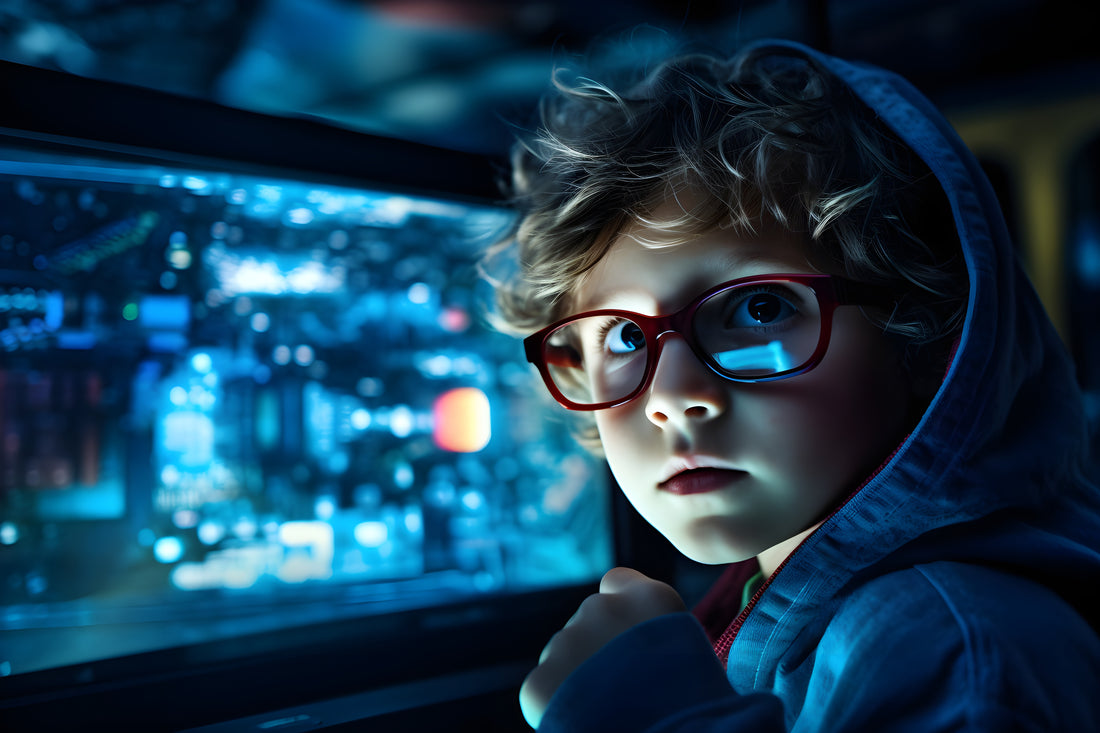Dear Parents, today we will focus on an aspect that has become an integral part of our family life in today's times - the eye health of our children. In a world where screen experiences are becoming commonplace, anti-blue light glasses step onto the stage as a potential protection for the delicate eyes of our little ones. What are they, how do they work, and is it worth introducing them into the lives of our children? We will seek answers to these questions together, exploring the world of eye protection in the era of modern technologies.
Introduction to Blue Light and Children's Development
In today's world, where screens are a constant element of children's lives, we begin our journey by understanding how blue light affects the development of their eyes. Young eyes are exceptionally sensitive to the intense light emitted by televisions, tablets, and smartphones. Analyzing the structure of a child's eye, we realize that the lens and retina become susceptible to the influence of this type of light.
We move on to consider why children are more vulnerable to the impact of blue light than adults. Anatomical and physiological differences make their eyes more susceptible to changes in the optical spectrum. The stages of eye development are also crucial – there are periods when protection against blue light becomes particularly important.
The next step is to understand the consequences of improper eye development in childhood. Vision problems can affect learning, social development, and the overall comfort of the child. Scientific studies show how prolonged exposure to blue light can impact the processes of perception and visual processing in children.
Finally, we delve into the role of anti-blue light glasses. You will learn how these special glasses can effectively block harmful blue light, minimizing the risk of negative effects on the health of the youngest eyes. This introduction lays the foundation for a more detailed analysis of the benefits of these accessories in the following chapters.
Benefits of Anti-Blue Light Glasses for Children
Let's now engage in a fascinating discussion about the benefits of children wearing anti-blue light glasses. Scientific research confirms that these special glasses have the ability to effectively reduce the negative impact of blue light on the eyes of the youngest. The mechanism of action is based on the use of filters that absorb harmful blue light waves, thereby creating a protective barrier for the lens and retina of the eye.
It is also worth examining other equally important health benefits arising from the regular wearing of anti-blue light glasses by children. Firstly, there is a confirmed link between wearing these glasses and improving the quality of sleep in the youngest. Studies indicate that limiting exposure to blue light can have a positive impact on a healthy circadian rhythm and facilitate the sleep process.
Additionally, we discover that reducing exposure to blue light can positively affect the overall mental well-being of children. Reduced susceptibility to stress, improved mood - these are effects that may result from caring for the eyes of the youngest with anti-blue light glasses. These additional aspects of the impact of glasses on the overall health of children bring a new perspective to the role of these accessories, showing that investing in eye protection becomes a key element of caring for the well-being of the youngest.
Blue Light Blocking Glasses as a Part of a Child's Daily Life

How to effectively encourage the youngest to wear these glasses? How to adapt the environment, both at home and at school, to support their eye protection?
Let's start by considering motivational strategies aimed at making wearing glasses a natural part of children's daily rituals. We will think about what design elements of glasses, such as colors or favorite cartoon characters, can make wearing them attractive for children. We will use a creative approach to make wearing glasses not only a necessity but also a way to express themselves.
At home, it is worthwhile to create a special place for their storage, attractive boxes, or stands so that the glasses are always easily accessible and at the same time an interesting element of the children's environment. At school, it is worth collaborating with teachers to ensure children's comfort in wearing glasses in the classroom, for example, by adjusting lighting or designating a place to store glasses in the classroom.
Let's also consider what additional incentives can be effective, such as rewards for consistent wearing of glasses or special events related to this theme. We will analyze how educational campaigns in schools can contribute to building a positive approach to wearing anti-blue light glasses.

